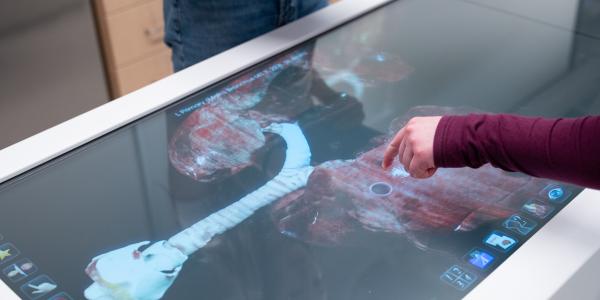A new digital dissection table — WashU’s first — allows students to explore human anatomy virtually.
Undergrads in WashU’s Department of Biology now have a chance to explore the intricacies of human anatomy and physiology — muscles, nerves, organs, and all — without ever approaching a cadaver. As part of a broader effort to upgrade and modernize its educational facilities, the department has acquired an Anatomage dissection table, an ultra–high-tech, interactive teaching platform that puts the complexity of the human body on full digital display.
“Everyone in the department who has seen the table in action has been blown away,” said Ram Dixit, professor of biology and chair of the department. “We’ve given undergraduate students an incredible opportunity to study human anatomy in ways that would have been unimaginable just a few years ago.”
The table — the first of its kind at WashU — consists of two flat screens that combine to make an 84-inch interactive surface where students can virtually slice, manipulate, and zoom in on any part of the body with remarkable clarity and precision.

During instruction, structures can be highlighted and identified with pins, tags, color-coding, and more. With the simple touch of a finger, the table will name structures and provide other relevant information, such as blood supply and innervation. In exam mode, students will have to fill in that information themselves.
“It’s a powerful teaching tool that inspires a lot of curiosity,” said Lisa Snoderly-Foster, an adjunct professor of biology who has been using the table in her vertebrate structure lab this semester.
Snoderly-Foster trained with the table over the summer, but she and her students are still learning together. “This group of students has been providing me with real-time feedback on different activities and helping me identify possibilities,” she said. “They get really enthusiastic about certain things they can do on the table.”


In a typical lab session, three students work on the screen at a time while the others follow along on Anatomage tablets equipped with much of the same software. If they’re studying the heart, for instance, students at the table can zoom in to see three-dimensional views of valves, vessels, and chambers. They can watch the blood flow, the heart beat, and the flow of electricity displayed on a simultaneous electrocardiogram — things that obviously aren’t possible with a cadaver.
The table can display males and females of various ages and different states of health, exposing students to the variety of the human condition. The images are compiled from actual cadavers, ensuring accuracy. But unlike actual cadavers, they can be dissected over and over again. “This is a very sustainable and ethical use of resources,” Snoderly-Foster said. “Even if they make a drastic slice through the torso, they can easily go back to the starting point and do it again or try something else. With a cadaver, once something is cut, it’s cut.”
Students in the vertebrate structure lab still dissect animals, a fundamental part of anatomy education. “Working with actual tissue is an important part of learning, and it helps students find out if they really want to pursue the medical field,” Dixit said.
“This is a very sustainable and ethical use of resources... With a cadaver, once something is cut, it’s cut.” — Lisa Snoderly-Foster
The acquisition of the dissection table is part of an ongoing mission to improve biology education at WashU. “When Dean Hu decided to renovate Jolley Hall to create new teaching lab spaces, it created the opportunity to think about new ways to elevate the learning experience,” Dixit said.
In future semesters, the table could be used in other biology classes beyond the vertebrate structure lab. Dixit notes that the table can display non-human animals, including monkeys, dogs, and frogs. “This could provide experiential learning for any course related to vertebrate anatomy, structure, and physiology,” he said.
As word spreads about the table, Dixit said he expects to see increasing demand for any classes that use the technology. “This is going to be an extremely popular part of learning at WashU.”





